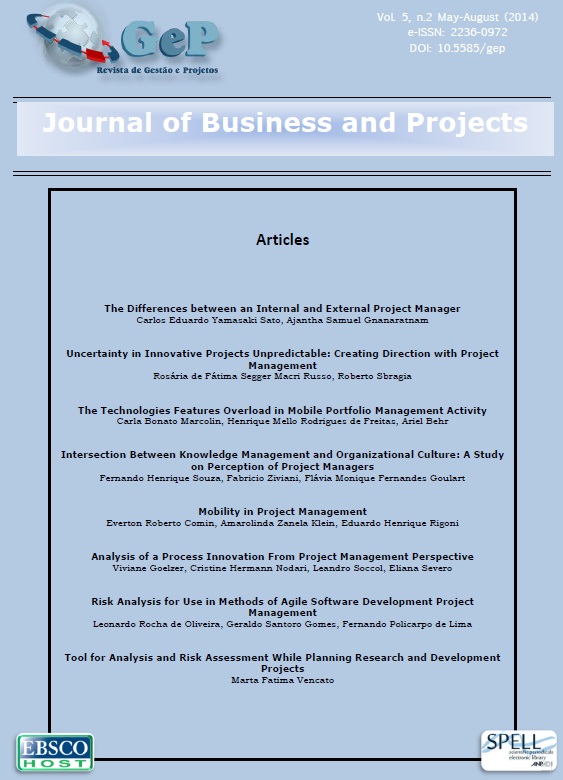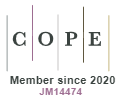Uncertainty in Innovative Projects Unpredictable: Creating Direction with Project Management
DOI:
https://doi.org/10.5585/gep.v5i2.204Keywords:
criação de sentido, incerteza imprevisível, gestão de projetos inovadoresAbstract
The more innovative a project is, the greater the probability of occurrence of unforeseeable uncertainty (unknown unknowns). This kind of uncertainty would be realized through the identification of early signs of a change, however for the recognition of these signs is necessary to sensemaking. Thus, this study aims to understand how project management makes sense of unforeseeable uncertainties in innovative projects and which practices are more efficient. A field survey was conducted which chose 16 projects and 35 unforeseen events as representative of unforeseeable uncertainties. Data analysis was initially qualitative grounded in-depth interview; in addition, a statistical analysis was made through non-parametric tests. The results pointed out that learning process (experimentation and improvisation) was more used in unforeseen events, risk management is not enought to identify unforeseeable uncertainty, and practices as collect information, collective sensemaking are more efficient. The results of this analysis suggest incorporating the diagnosis of unforeseeable to focus in information search about gaps in knowledge and socialize the knowledge of all team members and stakeholders.
References
Associação Brasileira de Normas Técnicas - ABNT (2009). ABNT NBR ISO 31000:2009 Gestão de riscos - Princípios e diretrizes. ABNT.
Association of Insurance and Risk Managers [AIRMIC], National Forum for Risk Management in the Public Sector [ALARM], Institute of Risk Management [IRM]. A Risk Management Standard. London: 2002. Disponível em: http://www.theirm.org/publications/PUstandard.html. Acesso em: 13.10.2010.
Committee of Sponsoring Organizations of the Treadway Commission [COSO] (2007) Gerenciamento de risco corporativo – estrutura integrada. Disponível em: http://www.coso.org/documents/COSO_ERM_ExecutiveSummary_Portuguese.pdf. Acesso em: 26.01.2011.
Choo, C. W. (1996, October) The knowing organization: How organizations use information to construct meaning, create knowledge and make decisions. International journal of information management, 16 (5), 329-340.
Creswell, J. W. (2007) Projeto de Pesquisa: métodos qualitativo, quantitativo e misto. (2a. ed, L.O. Rocha, Trad.) Porto Alegre: Artmed. (Obra original publicada em 2003).
Dervin, B. (2008, 20/25 July) Interviewing as Dialectical Practice: Sense-Making Methodology as Exemplar. In: International Association of Media and Communication, Stockholm, Sweden.
Higuera, R., & Haimes, Y. (1996) Software Risk Management. Pittsburgh: Carnegie Mellon, Software Engineering Institute.
Hiltunen, E. (2008) The future sign and its three dimensions. Futures, 40 (3), 247-260.
HM Treasury (2004) Orange Book: Management of Risk – Principles and Concepts. London: HMSO publications.
Kappelman, L.A., Mckeeman, R., & Zhang, L. (2006, fall) Early warning signs of it project failure: the dominant dozen. Information Systems Management, 23 (4), 31-36.
Loch, C.H., Meyer, A. D., & Pich, M. T. (2006) Managing the Unknown: a new approach to managing high uncertainty and risk in projects. New Jersey: John Wiley & Sons.
Loch, C.H., Solt, M.E., & Bailey, E.M. (2008) Diagnosing Unforeseeable Uncertainty in a New Venture. Journal of Product Innovation Management, 25 (1), 28-46.
Murray-Webster, R. & Pellegrinelli, S. (2010) Risk management reconceived: reconciling economic rationality with behavioural tendencies. Journal of Project, Program & Portfolio Management, 1 (1), p. 1-16.
Nikander, I. O. (2002) Early warnings: a phenomenon in project management. Tese de doutorado em ciência da tecnologia – Helsinki Universit of Technology, Estocolmo.
Nikander, I.O., & Eloranta, E. (1997) Preliminary signals and early warnings in industrial investment projects. International Journal of Project Management, 15 (6), 371-376.
Nikander, I.O., & Eloranta, E. (2001) Project management by early warnings. International Journal of Project Management, 19 (7), 385-399.
Office of Government Commerce [OGC] (2005) Managing successful projects with Prince2. 4th. ed. London: The Stationery Office.
Organization for Economic Co-Operation and Development [OECD] (2005) Oslo manual: guidelines for collecting and interpreting innovation data. 3rd ed. Paris: OECD.
Pender, S. (2001, February) Managing incomplete knowledge: Why risk management is not sufficient. International Journal of Project Management, 19 (2), p. 79-87.
Project Management Institute (2009) Practice Standard for Project Risk Management. Newton Square: author.
Project Management Institute (2013) PMBOK Guide – A guide to the Project Management Body of Knowledge, 5th ed., Newton Square: author.
Perminova, O., Magnus, G., & Wikstro, K. (2008, January) Defining uncertainty in projects – a new perspective. International Journal of Project Management, 26 (1), 73-79.
Russo, R. de F. S. M. (2012) Criando sentido para as incertezas imprevisíveis em projetos inovadores. Tese de doutorado, Universidade de São Paulo, São Paulo, SP, Brasil.
Sadler-Smith, S.; Leyborne, E. (2006) The role of intuition and improvisation in project management. International Journal of Project Management, 24 (6), p. 483-492.
Sanchez, A. M., & Perez, M. P. (2004) Early warning signals for R&D projects: An empirical study. Project Management Journal, 35 (1), 11-23.
Shenhar, A., & Dvir, D. (2007) Reinventing Project management: the diamond approach to sucessful growth and innovation. Boston: Harvard Business School Press.
Siegel, S., & Castellan, N. J., Jr. Estatística não-paramétrica para as ciências do comportamento. (2ª ed., S. I. C. Carmona, Trad.) Porto Alegre: Artmed, 2006. (Obra original publicada em 1988).
Simon, L. (2006, February) Managing creative projects: an empirical synthesis of activities. International Journal of Project Management, 24 (2), 116-126.
Strauss, A., & Corbin, J. (2008) Pesquisa qualitativa: técnicas e procedimentos para o desenvolvimento de teoria fundamentada. (2a. ed, L. O. Rocha, Trad.) Porto Alegre: ARTMED.
Thiry, M. (2001) Sensemaking in value management practice. International Journal of Project Management, 19 (2), 71-77.
Weick, K. E. (1995) Sensemaking in Organizations. London: Sage.
Weick, K. E. (2006) Faith, Evidence, and Action: Better Guesses in an Unknowable World. Organization Studies, 27 (11), 1723-1736.
Weick, K. E., Sutcliffe, K. M., & Obstfeld, D. (2005, Jul./Aug.) Organizing and the process of sensemaking. Organization science, 16 (4), 409-421.
Wideman, R. M. (Ed.) (1992) Project and Program Risk Management: A Guide to Managing Project Risks and Opportunities. PMI. Disponível em: http://pmi.books24x7.com/viewer.asp?bookid=5607. Acesso em: 04.11.2010.
Williams, T. M. (1999, October) The need for new paradigms for complex project. International Journal of Project Management, 17 (5), 269-273.
Downloads
Published
How to Cite
Issue
Section
- Abstract 650
- PDF (Português (Brasil)) 842







